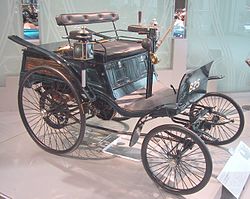Benz Velo
| Benz Velocipede | |
|---|---|
Benz Patent Motorwagen |

The Benz Velo was one of the first
Preceding events
Carl Benz patented the world's first stationary, static Internal combustion engine. His patent created a great demand for his vehicles, forcing Benz to move his operations in 1886 to a new factory on Waldhofstrasse in Mannheim (operating until 1908). Benz had appointed a Board of Management to help aid his growing company. The appointees suggested to Benz that he should create a less-expensive automobile suitable for mass production. In response, Benz engineered a two-passenger automobile with a 3-metric-horsepower (3 hp; 2 kW) engine, which he called the Victoria. That model could reach a top speed of 18 km/h (11 mph), and utilized a pivotal front-axle operated by a roller-chained tiller for steering. 85 units of the Victoria were produced. Improving on those designs, Benz created his Benz Velo.[citation needed]
Influences
Following automobiles
The Velo also inspired numerous copies, including Marshall (later Belsize) in Manchester,[3] Star (Wolverhampton),[4] and Arnold (Paddock Wood, of which only twelve were built).[4] Benz's Velo was particularly popular in France, where a Parisian bicycle manufacturer by the name of Émile Roger had been building Benz engines under license from Karl Benz. Roger began building Benz automobiles as well, and as a result, a majority of Benz automobiles were sold in France initially.[citation needed] Many British Inventors also used Benz's patents and automobiles as starting points for their own innovations. Frederick W. Lanchester, of Birmingham, built a four-wheeled petrol-driven automobile, similar to units previously designed by Benz, which had utilized an electric starter (an adaption first seen in the Benz Velo).[citation needed]
A Velo was the first car introduced to South Africa, where it was demonstrated to then President Paul Kruger on 4 January 1897.[5]
The first automobile race
Karl Benz's Velo participated in the world's first automobile race. A Parisian daily newspaper, by the name of Le Petit Journal, organized the race. The editors of Le Petit intended to display horseless carriages as a viable means of transportation. Rather than fastest time, the automobiles would be judged on whether they were safe and cost effective to operate.[6] It took place in 1894, starting in Paris and ending in Rouen. The winners of the Paris-Rouen race were Panhard & Levassor (Panhard) and Peugeot, both French manufacturers using Benz internal combustion engines. The Velo placed fifth overall in Le Petit's race. Benz had proven with this race that his engines and his automobiles were not only attainable but also safe and reliable to operate. Eventually, manufacturers began optimizing automobile design for racing. In addition to promoting Benz and his automobiles, the Paris-Rouen race gave birth to modern Motorsport, which now includes the likes of Formula One.[7]
See also
- List of automotive superlatives
- Timeline of most powerful production cars
- List of Mercedes-Benz vehicles (includes section on Benz vehicles)
- Benz Viktoria
References
- ^ "The First Mass Production of Cars - The Assembly Line". theinventors.org. Retrieved 2 June 2023.
- ^ Danielson, C. "The World's First Production Car, The Benz Patent Motor Car Velocipede Of 1894". eMercedesBenz. Archived from the original on 24 March 2015. Retrieved 22 March 2015.
- G.N. GeorganoCars: Early and Vintage, 1886-1930. (London: Grange-Universal, 1990), p.24 caption.
- ^ G.N. Georgano, p.24 caption.
- ^ "History and Background - Mercedes Benz Club South Africa". www.mercedesbenzclub.co.za. Archived from the original on 15 September 2016. Retrieved 2 September 2016.
- ^ Andrews, Evan (22 July 2014). "World's First Automotive Competition Held, 120 Years Ago". History.
- ^ "Birth of Motor Sport 120 Years Ago". Daimler AG. Retrieved 2 May 2015.
